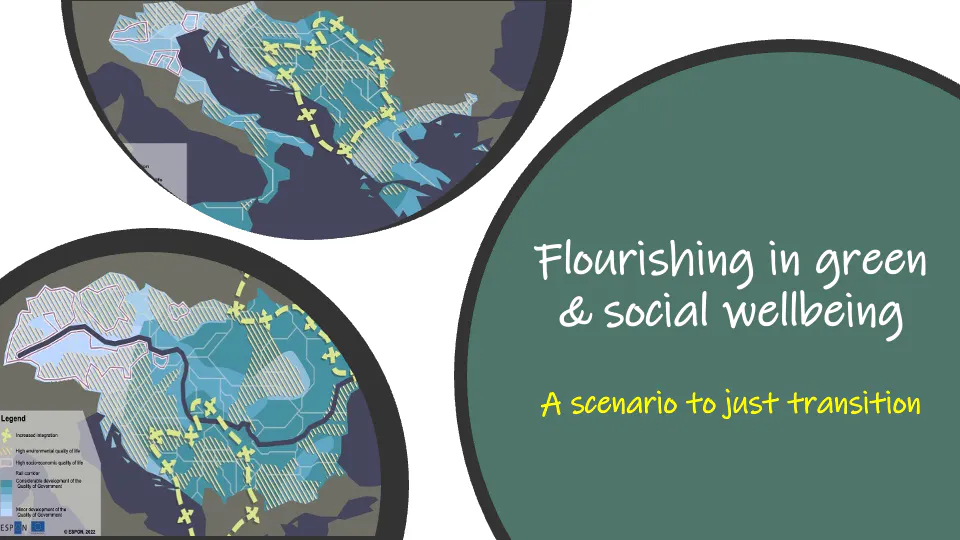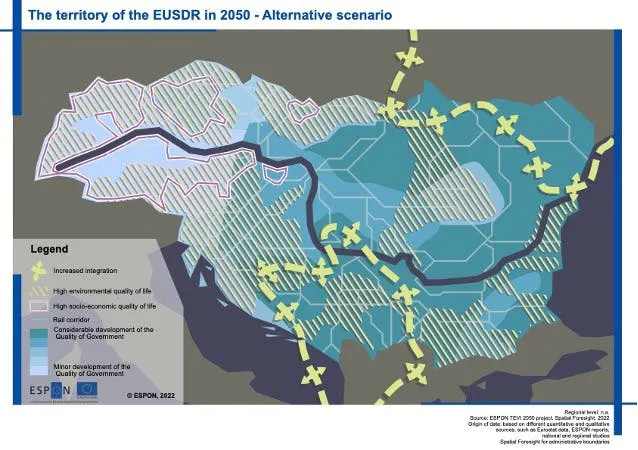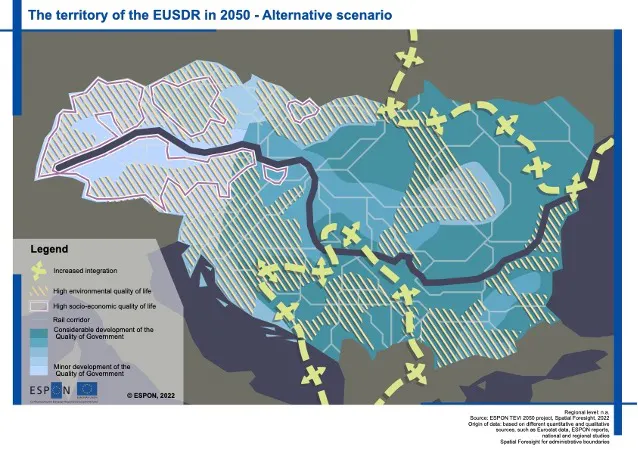Flourishing in green and social wellbeing: A scenario to just transition
August 2022

Scenarios are eye-openers
allowing thinking out-of-the-box
Thinking beyond personal biases and unfreezing mental barriers are necessary when thinking about the future. Foresight methods can stimulate this way of thinking and prompt people to increase their social imagination. Therefore, they can be used as a process to explore and discuss different pathways for the EU digital, green and just transitions. With the example and material from the ESPON TEVI 2050 project, we have looked in earlier blogspots into a possible future path towards the digital transition (Opens in a new window) and the green transition (Opens in a new window), drawing on the example of the Danube and the Adriatic Ionian macro-region. This blogspot brings these two territories together, looking at both, and focusing on the just transition. The just transition aims at a fair process towards a climate neutral economy that leaved no one behind and eases its socio-economic impact.

Flourishing in green and social wellbeing – a territorial scenario for the Adriatic Ionian region. By 2050, the Danube and the Adriatic Ionian macro-regions focus on increasing the quality of life of their citizens, putting aside the immense economic growth, but rather concentrating on the ecological and social enablers that can improve their lives. This means that on the one hand, focusing on healthy environments and being close to nature are parts of a good life, while on the other the social sphere, i.e. increasing the trust in government and services and in public participation give a new element to the meaning of prosperity. This process has gradually started in the 2020s and kept a rather stable process until the 2050s (see figure), while territories with high environmental quality of life, like the north west and south west, and the east parts of the Danube region, or the central and eastern part of the Adriatic Ionian regions (see maps) demonstrate higher ecological quality of life. Similarly places with high socio-economic quality of life are frontrunners in this aspect, as shown in the maps. Prosperity is also seen as a matter of trust, with trust in governments and services increasing, while more citizen participation in decision making has also contributed to that. Through its strategic autonomy, the EU has become a strong regulatory player in the EU functioning as a large umbrella organisation, safeguarding its sustainability rules and social charter through its legislation (see figure). This development started very slowly in the 2020 and very slowly increased over the years by 2050, as such developments need substantial time to take shape

The high degree of digitalisation by 2050, which took rather an uptake after the 2030s, played a key role (see figure). As a result, even territories with a low quality of government leapfrogged by 2050 towards a better quality of government, as seen e.g. in the south of the Adriatic Ionian macro-region or the Western Balkans area, as well as in the East of the Danube macro-region (see maps).

Through its strategic autonomy, the EU has become a strong regulatory player in the EU functioning as a large umbrella organisation, safeguarding its sustainability rules and social charter through its legislation (see figure). This development started very slowly in the 2020 and very slowly increased over the years by 2050, as such developments need substantial time to take shape (see figure). All this helped in achieving the Green Deal faster and even taking it a step further, gradually becoming carbon neutral by 2050. This has not been an easy task, but rather started very slowly and influenced by external energy shocks, to take up around the 2040s (see figure).
All these developments, like the increasing citizen involvement in decision making, the increasing importance of wellbeing with a ecological and social focus, as well as the new global role of the EU, have come together to slowly develop a strong European common culture based on EU’s core values, such as human dignity, democracy, freedom, equality, rule of law, something that although was at a low end in the 2020s, over the years, in increased substantially to then stabilise by the 2050s (see figure). Such development is seen in the stronger integration of non-EU member states, such as Moldavia, the Western Balkans, and Ukraine (see map), as well as the Western Balkans (see map).
What can this future teach us?
Flourishing in green and social wellbeing shows that the Danube and the Adriatic Ionian macro-regions have been bold in putting their citizens’ quality of life first. This came with coupling the digital and green transitions by ensuring that they no one behind, but rather serve the purpose of a good life for the regions’ people. This has been a task for which a lot of effort is required, where stronger policies are necessary, where citizens are involved in the policy making and bottom-up approaches are encouraged, while the EU keeps a safeguarding and rather global position. The scenario has shown that the choices we make today are vital for the wellbeing of people, whom policy makers need to involve to create desirable futures.
The scenarios are part of the work carried out in the framework of the ESPON TEVI 2050 project. The reports of the project are to be found on ESPON’s project dedicated website (Opens in a new window).
by Maria Toptsidou
https://steadyhq.com/en/spatialforesight/posts/7cae0136-7e0d-4d62-ab84-ebd698ad94ee (Opens in a new window)

